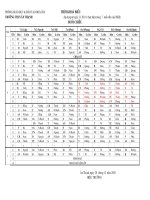Bài giảng nha khoa Mandibular movements and positions
Bạn đang xem bản rút gọn của tài liệu. Xem và tải ngay bản đầy đủ của tài liệu tại đây (1.05 MB, 28 trang )
§MANDIBULAR MOVEMENTS and POSITIONS
People’s Teacher
Prof. Hoàng Tử Hùng, DDS, PhD
E:
W: hoangtuhung.com
MANDIBULAR MOVEMENTS
HoangTuHung.com
1. CLASSIFICATION OF THE MANDIBULAR MOVEMENTS
According
Accordingto
tothe
theform
formof
ofmovements
movements
Rotation movement: the act of turning about an axis or a center.
Stationary axis: the axis remains in the same position during the movement
Momentary axis: the axis shifts its position during the progress of the movement
Translation movement: movement of the mandible in which all parts move in
the same direction at the same speed
HoangTuHung.com
1. CLASSIFICATION OF THE MANDIBULAR MOVEMENTS (cont’d)
According to the direction of movements
Opening and closing: symmetric or asymmetric
Forward and backward
Symmetric or asymmetric
With or without contact between the upper and lower teeth
(contact or gliding movement)
Lateral gliding movement
HoangTuHung.com
1. CLASSIFICATION OF THE MANDIBULAR MOVEMENTS (cont’d)
According to the kinesiology of occlusion
Border movements: the most extreme position to which the jaw is able to move
Contact movements: the movement in which the upper and lower teeth
maintain contact (gliding or sliding movement)
Free movements (intra-border mov.): the mandibular movements in which a given
reference point does not reach its border and the teeth do not come into contact
HoangTuHung.com
MECHANICS OF CONDYLAR MOVEMENT
Nature of condyle-disc assembly in mandibular movements
The structure of two synovial compartments facilitates
rotational and translational movements of the condyle disc
assemblies
The disc generally moves together with the condyle and
can slide forwards and backwards over the condyle.
The loose retrodiscal tissue is seated posteriorly to the
disc, filled the temporal fossa and moved forwards and
backwards toghether with the disc
HoangTuHung.com
2. BORDER MOVEMENTS AND POSITIONS OF THE MANDIBLE
RECORDED IN THE SAGITTAL PLANE (POSSELT’S DIAGRAM )
The posterior opening border movement
If the mandible is held back by either patient or operator
and carries out [guide] the act of opening and closing:
- a hinge movement can be performed
- the incisive point*trace the arc from CR to B (distance
between the incisal edges is about 20 – 25 mm).
Mandible movement maintains around the horizontal stationary
rotation axis (hinge axis) through the two condyles (C)
This movement is called the terminal hinge movement
The position of condyles is named
‒ Terminal hinge position
‒ Centric relation (CR)
*The midpoint between the two mesioangles of lower central incisors
‒ Retruded contact position incisalHoangTuHung.com
The posterior opening border movement (cont’d)
If an attempt is made to open the jaw further below B:
- the condyles move forward and downward on posterior
slope of the articular eminence (translation movement)
- the axis of rotation is moved downward and forward,
about at D
- the incisive point moves down to E (extreme or maximal
opening), the distance between the incisal edges is about
50 – 60 mm)
The diagram recorded in sagittal plane of posterior border movement
is a diphasic curve: upper and lower arcs concave backward
HoangTuHung.com
The protrusive closure movement
The movement of protrusive closure from maximum opening (E) stops
when the posterior teeth make contact at F (protruded contact position)
The F is located 10 – 12 mm anterior to CR
The diagram is recorded a curve concave backward
This movement has slight practical value only
HoangTuHung.com
The propulsive gliding movement
The propulsive path from retruded contact position (CR) to protruded contact
position (F):
− an irregular path due to tooth guidance
− the shift of the incisal point is about 10 – 12mm
passes from CR through:
− (maximal) intercuspal position (IP or MIP),
− edge-to-edge position, and
ends in the protruded position (F)
Note: Tooth-guided protrusive, lateral, and laterotrusive movements are called
”excursive movements” or ”eccentric movements”
HoangTuHung.com
INCISAL GUIDANCE AND CONDYLAR GUIDANCE
Voluntary protrusion from MIP is guided:- anteriorly by the incisal guidance, and
- posteriorly by condylar guidance
Incisal guidance (or anterior ̴): the palatal inclines of the
maxillary incisors guide the incisal edges of lower incisors
In natural dentition, contact may occur on centrals, on
centrals and laterals, and on centrals, laterals and
canines
Condylar guidance: Protrusive condylar guidance is
guided by the distal inclines of the temporal eminence as
the condyles-disk assemblies move down their inclines
HoangTuHung.com
BORDER MOVEMENTS IN THE HORIZONTAL PLANE
Border Movements of the Mandible Recorded in the Horizontal plane:
the Gothic Arch or Gysi’s tracing
If mandible in centric relation (CR), as the mandible moves
in retrusive lateral excursion to the left, the incisive point
records the line CR – L
From L, mandible can be move forward and medially to F
A similar tracing can be record from CR for the right side
(CR – R and R – F)
These border movements give a rhomboid figure
As mandible move straight anteriorly from CR, the slide
movement tracing the line CR - F that was seen in the
propulsive gliding movement recorded in sagittal plane
HoangTuHung.com
CR
MIP
L
R
F
BORDER MOVEMENTS IN THE HORIZONTAL PLANE (cont’d)
The lateral movement of the mandible starting from retruded contact position:
− a turn (or swing) to one side
− an asymmetric rotation combined with a slight translation movements
•
•
The side to which the mandible moves is named
“working side”; the condyle of this side is
“working condyle”
The opposite side is the “non-working side”; the
condyle of this side is “non-working condyle”
Theoretically, lateral movement could involve a rotation
around static vertical axis at the working condyle
Working
condyle
Working side
Really, working condyle will shift laterally (Bennette movement)
HoangTuHung.com
Non-working
condyle
Bennette movement and Bennette angle
Bennette movement (lateral shift, side shift, Bennette shift): Working
condyle
the lateral shift of mandible toward working side during
lateral excursion.
It is measured by the distance that working condyle moves
laterally (may have a straight or retrusive, or protrusive in
direction); the average of bennette movement measured in
the horizontal plane: ≈ 0.5 - 1.5 mm
Bennette angle: When a mandible move laterally, the
non-working condyle moves down, forward and inward.
The angle that non-working condyle makes with the
sagittal plane when projected perpendicularly on
horizontal plane
HoangTuHung.com
Non-working
condyle
BORDER MOVEMENTS IN THE FRONTAL PLANE
In the frontal view, border movements from MIP generally have shield-shaped
pattern which consist of four components
•
•
•
•
Left lateral superior border movement
Left lateral opening border movement
Right lateral superior border movement
Right lateral opening border movement
HoangTuHung.com
MANDIBULAR POSITIONS
Centric Relation
Centric Occlusion
Maximal intercuspal Position (MIP) or Intercuspal Position (IP)
Rest position
HoangTuHung.com
Centric Relation Definition
Centric relation (CR) has been a controversial subject in dentistry for more than a
century.
Centric relation is the relationship of the mandible to the maxilla when the
properly aligned condyle-disc assemblies are in the most superior position
against the eminences irrespective of vertical dimension or tooth position
(Dawson, 2007)
Centric relation (acronym: CR) a maxillomandibular relationship, independent of tooth
contact, in which the condyles articulate in the anterior-superior position against the
posterior slopes of the articular eminences; in this position, the mandible is restricted
to a purely rotary movement; from this unstrained, physiologic, maxillomandibular
relationship, the patient can make vertical, lateral or protrusive movements; it is a
clinically useful, repeatable reference position (Glossary of Prosthodontic Terms, 2017)
HoangTuHung.com
Centric Relation Definition (cont’d)
Condyle-disc assembly in centric relation
In centric relation, the disc is positioned on top of the condyle
at the most forward position that posterior ligament allows.
“The condyles articulate in the anterior-superior position
against the posterior slopes of the articular eminences” (GPT*
2017)
Centric relation is the relationship of the mandible to the
maxilla when the condyle-disc complex are properly
aligned against posterior slope of the eminences in
anterior-superior position i.e., condyles are related to
posterior slopes with the intermediate zones*of the discs
interposed
*Intermediate zone is the thinnest, avascular, noninnervated part
of the disc that accept loading
HoangTuHung.com
Terminal Hinge Movement and Centric Relation
centric relation (CR) position: the position of condyles from which a hinge axis
movement can occur
− Centric relation is charactered by the properly aligned
condyle-disc assembly and are positioned in their
superior anterior position in the articular fossae
The condyles rotate against the posterior slope of the
articular eminence in the lower joint compartment
CR is not related to the teeth!
− When the jaw muscles are completely relaxed, the
mandible can be guided to open and closed in a terminal
hinge (hinge axis movement) which is a pure rotation
movement without translation of the condyles (the
terminal arc of rotation [CR – B – CR])
HoangTuHung.com
Terminal Hinge Movement and Centric Relation: Practical Aspect
Semantically, the term “centric relation” describes
an arc of rotation of the mandible
In CR (terminal hinge axis of the mandible),
the opening and closing movements are
- reproducible,
the relation between upper and lower jaws can
- recordable, and
- transferable (to the articulator)
CR is stable position and is the key reference position for analysis, occlusal
contact evaluation and rehabilitation or reconstruction of masticatory system
HoangTuHung.com









